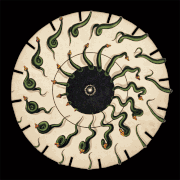The phenakistoscope – literally “eye deceiver”[1] – is an optical toy that gives the impression of moving images, a significant precursor to the development of early cinema. It consists of a cardboard disc containing a series of sequential images, the reflection of which in a mirror is viewed through a series of moving slits. Popular during the Victorian era, especially with children, it was invented by the Belgian Joseph Antoine Ferdinand Plateau in 1833, and was available in Britain under the names of Phantasmascope and Fantascope.[2]
There is no universally accepted theory as to why such a series of still images, the bedrock of television and the motion picture industry, is able to create the illusion of apparent motion. It was initially thought to be the result of a phenomenon known as visual persistence, the idea that an after-image remains on the retina of the eye or is stored by the brain for about one twenty-fifth of a second, before it decays and is replaced by the next image. But that idea is now generally discredited,[3] succeeded by beta movement and the phi phenomenon as the most plausible explanations of why motion pictures appear to move,[4] although both not without their critics.[1]
The work of the psychologist Paul Kolers concluded that there are two types of apparent motion, short-range and long-range, with different neural mechanisms involved in each. In the former, the perception of movement results from multi-element or closely spaced displays which, as the visual system is apparently incapable of distinguishing between real motion and short-range apparent motion, has been suggested as an explanation for the illusion of moving pictures.[1]
Gallery

Men throwing balls to frogs

Horseback riders and somersaults

Snakes emerging from a central disc

Men swinging axes at bogles

